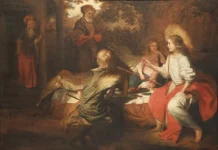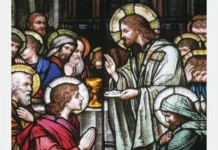When he heard the voice of the Mother of God, St. John the Baptist was immediately purified of original sin. This prodigy foretold the great transformations in store for those who, throughout history, would be the object of Mary’s maternal intercession.
Gospel of the Fourth Sunday of Advent
39 In those days Mary arose and went with haste into the hill country, to a city of Judah, 40 and she entered the house of Zechariah and greeted Elizabeth. 41 When Elizabeth heard the greeting of Mary, the babe leaped in her womb; and Elizabeth was filled with the Holy Spirit 42 and she exclaimed with a loud cry, “Blessed are you among women, and blessed is the fruit of your womb! 43 And why is this granted me, that the mother of my Lord should come to me? 44 For behold, when the voice of your greeting came to my ears, the babe in my womb leaped for joy. 45 And blessed is she who believed that there would be a fulfilment of what was spoken to her from the Lord” (Lk 1: 39-45).
I – Human Perspective and the Perspective of Faith
The Apostle teaches that “he who through faith is righteous shall live” (Gal 3: 11). This affirmation highlights the natural insufficiency of our reason to grasp, on its own, certain truths of the Catholic Religion. When the intelligence disassociates itself from God, it loses the capacity to capture the most essential aspect of reality: His presence in the soul and in the entire created universe. We find clear testimony of this with St. Augustine who, after roaming the world of thought in vain, searching for the meaning of his existence, exclaimed: “You were within me, more inward than my most inward part and higher than the highest element of my being.” 1 Now, this knowledge was given to him through faith, for human vision cannot distinguish God directly. 2
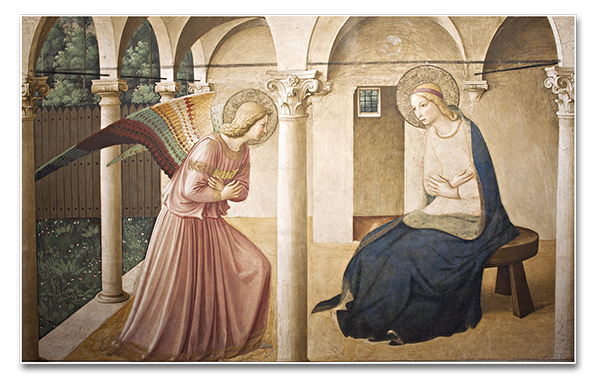
It is equally impossible to comprehend Sacred Scripture with the intelligence alone. The latter is inferior to the supernatural amplitude of the episodes of Sacred History, especially the Gospels. At a given moment, it becomes necessary to open up to the inspirations of the Holy Spirit in order plumb its divine meaning. We should meditate on these facts as events driven by the direct and efficacious action of the Creator.
From this perspective let us contemplate the simple narrative of the mystery of the Visitation recalled by the Gospel of this fourth Sunday of Advent. It refers to a lady who sets out on a journey to visit her cousin who is soon to be a mother, in order to offer her assistance. They meet, and manifest their mutual affection. It is a modest scene, cloaked as a mere family episode, but it encompasses unfathomable depths, worthy of consideration and, above all, meditation.
II – Sanctity, a communicative Good
Following the narration of the Angel’s apparition to Zechariah, made by St. Luke in a dialogue of a few verses (cf. Lk 1: 11-20), the Evangelist adds that “the people were awaiting […] and they wondered at his delay in the Temple” (Lk 1: 21). This detail reveals that the conversation must have been more extensive than the brief phrases registered in the sacred text. If this was so with this apparition, what of the succinct narration of St. Gabriel’s encounter with the Blessed Virgin (cf. Lk 1: 26-38)? We may infer that the colloquy was not a fleeting one, but that, out of humility Mary wished to leave recorded only what was strictly necessary for a clear understanding of the Heaven-sent tidings. With full knowledge of the great privilege that it was to converse with her, the celestial messenger was doubtless eager to derive full profit from the dialogue. And what elevated thoughts Mary must have expressed to St. Gabriel! Did she seek his counsel? The great perfection of the Angel’s spiritual nature, added to his proximity to God, certainly inspired a holy affinity with the angelic world in Our Lady.
Among the themes of this dialogue, we may suppose that she included the advisability of her visiting her cousin St. Elizabeth, who was in her sixth month with child, as the Angel had told her. Mary hastened to manifest her readiness to go to her—which, as we shall see, was entirely based on supernatural reasons—although it was probable that before this, she spent a period in recollection, due to the extraordinary influx of graces that she had just received. She did not judge herself excused from the obligation of serving her neighbour, but promptly set about fulfilling this charitable plan, as the Evangelist narrates.
Efficacious action is born of contemplation
39 In those days Mary arose and went with haste into the hill country, to a city of Judah.
After giving her free consent for the Incarnation to take effect, by an act of supreme fidelity to the will of God (cf. Lk 1: 38), Our Lady did not forsake societal life, as her visit to her cousin reveals. She knows that she is expecting the Son of God; she has become Mother of the Second Person of the Most Blessed Trinity, yet she thinks of a cousin. Would anyone else do this? An egoistic soul would wish to embrace a misapprehended contemplative life after receiving the Angel’s annunciation, to bask in her prerogatives and savour the consolations of her relationship with the Child Jesus. Mary did the opposite: she set out promptly, “in those days,” for the innocent are more concerned with others than with themselves.
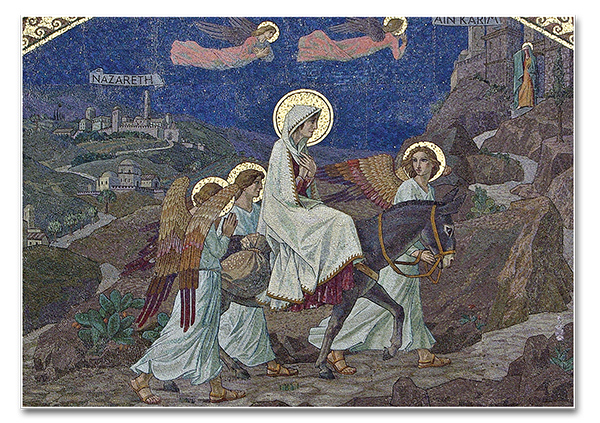
Jerusalem was situated on the heights of a mountain at an altitude of approximately 800 metres and the city where Zechariah lived—Ein Karem, according to ancient tradition—was located in a valley, seven kilometres to the southeast of the Holy City. Now, Nazareth was located at a considerable distance—around 130 kilometres—which required a three to five-day journey by an arduous and solitary path through the valleys of Samaria and the mountainous regions of Judea. 3 Our Lady resolutely faced all of these hindrances to reach the little town. But we would be far from understanding her state of spirit during this trip, if we failed to recognize the relationship between her promptness on this trip and her intense interior life.
She is a meditative soul, imbued with a strong spirit of prayer, and shows us that good contemplation results in action well carried out; it gives glory to God and edifies one’s neighbour. We should be convinced that fervent spirits accomplish their mission with the greatest success, because they act under the guidance of the Holy Spirit. In this case, Mary “is impelled by a divine movement, by the Word whom she carries in her womb. This divine burden, far from delaying her, elevates her, makes her fly, transports her to the mountain heights.” 4
Haste, a sign of fervour
Another detail surfaces in the Evangelist’s phrase: “with haste.” Why did she want to leave as soon as possible to be with her cousin? After the Annunciation, the Blessed Virgin was favoured with a new plenitude of the Holy Spirit and was exultant with joy. Because goodness is self-diffusive, 5 Our Lady, who had no mark of sin and in whom was all sanctity and virtue, immediately desired to share the treasures received. She could not speak openly with St. Joseph, for subsequent facts indicated that Providence had different designs in his regard, demanding generous confidence of him in the unfolding of events that were only clarified for him gradually. This is why Mary chose to leave any communication to be made to her spouse in God’s hands. However, since the Angel had told her that St. Elizabeth was in the sixth month of a miraculous conception, Mary judged this to be the ideal occasion for visiting her, knowing, as well, that her cousin had no one on hand to assist her adequately.
She set out promptly, for supernatural life does not admit tardiness, laziness or detours. It should be observed that to act with haste does not mean being perturbed by agitation; there is no doubt that she proceeded with complete balance and inner calm. The haste came from the desire to communicate the marvels she carried within her, and although she was entirely disposed to aid in practical needs as well, this was not the most important reason. Her esteem for her cousin made her certain that she could find no better interlocutor, since Elizabeth “was in a certain way involved in the mysteries of Redemption.” 6 For love of her Divine Son whom she bore, she set out swiftly along the way, as St. Ambrose comments: “Hastened by gladness, she headed to the mountain. Being filled with God, how could she not be drawn to the heights? Slow calculations are unknown to the grace of the Holy Spirit.” 7
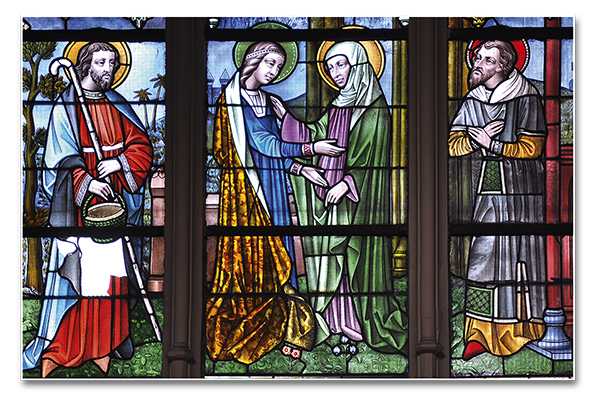
There was an additional and even more significant motive that determined the journey, related to the person and missions of St. John the Baptist. The Most Blessed Virgin undoubtedly knew, by angelic revelation, that the son to whom St. Elizabeth would soon give birth was the Precursor and, for this reason, was certain that he was linked in a particular way with the plan of salvation. She wanted to collaborate in promoting the greatest possible glory for her Divine Son, with a desire corresponding to her soul’s high degree of perfection and sanctity. Her haste coincided with the intention of sanctifying the Precursor as soon as possible; the idea that this great man could come into this world marred by sin clashed with her aspirations.
Our Lady went quickly, then, to transmit the Good News exclusively to St. Elizabeth and to St. John, becoming, in this way, the first herald of the Gospel in history. Of this, Monsabré states: “She fears neither the difficulties nor the fatigue of the journey, for she brings the grace of God, and grace is a gift so great that we should be willing to endure all sacrifices to take it to those for whom it is destined.” 8
The effects of a visit from Mary
40 And she entered the house of Zechariah and greeted Elizabeth. 41 When Elizabeth heard the greeting of Mary, the babe leaped in her womb; and Elizabeth was filled with the Holy Spirit.
How did Mary greet Elizabeth on this occasion? St. Luke is silent, but everything indicates that in her supreme humility, she arrived discreetly, without drawing attention to herself. Seeing her cousin, she greeted her by name, and the Holy Spirit operated in a perceptible way.
God is so gracious—He is Graciousness itself—that as these two chosen souls approached each other, He filled St. Elizabeth with graces, communicating to her that the fullness of time had arrived and that the Messiah was present in the virginal womb of Our Lady. Mary, for her part, saw that it was unnecessary to explain anything to her cousin.
We may imagine the unction and the power of the voice of the Mother of God by its effects. Any earthly music, regardless of its beauty and perfection pales by comparison. It is a voice of extraordinary strength, penetration and efficacy! In saying “Elizabeth,” Mary spoke with such love that her intonation was charged with supernatural meaning, sweetness and sublimity, for “out of the abundance of the heart the mouth speaks” (Mt 12: 34).
The fact that St. John the Baptist leaped in the womb of St. Elizabeth is a sign of this. Theological tradition recognizes it to have been at this moment that original sin was expunged from the child, just as if he had been baptized. Although a child of six months’ gestation has not yet the capacity to understand, he was the object of a remarkable mystical phenomenon which, according to the affirmation of certain authors, gave him a flash of rational knowledge. Even so, it seems more in conformance with faith that the divine life, existing in Mary in plenitude and superabundance, 9 would have been transmitted to him by the sound of that virginal and sanctifying voice. Grace penetrated him, giving him a true Baptism, which infused him with virtues and gifts, filling him with the Holy Spirit.

“The mystery of the Visitation was a torrential effusion of graces. Grace washed over the Precursor, sanctifying his life, illumining his intelligence, inaugurating and consecrating his mission; this leaping was the clearest indication of the presence of the Word.” 10 At the instant of St. John the Baptist’s purification, St. Elizabeth was assumed by the Holy Spirit. Through whom did this grace come to her? What means did the Divine Paraclete choose to imbue her with such benefits? He used that which overflowed from His Spouse, which was more than sufficient to elevate Elizabeth to the summit of perfection. Throughout her life Mary was always adorned with an extraordinary influx of graces that increased continually until the moment of her departure for eternity.
Understanding the effect of the Blessed Virgin’s voice is magnificent knowledge. God chose water for the institution of Baptism and, as a sacramental sign, it has the power to wash away sin, upon the invocation of the Holy Spirit. But more powerful still is the voice of Mary that sanctified St. John in his mother’s womb! She acted as intercessor even before being crowned Queen of Heaven and of Earth. At her voice and with her desire, the child was cleansed of original sin and leaped with joy.
We see, then, that any transformation or spiritual progress is possible when Our Lady inclines herself toward a soul. As St. Thomas teaches, love which descends is efficacious11 and, coming from God and Our Lady, it sanctifies. In this sense, therefore, we observe a relevant truth: with regard to our superiors in the spiritual realm, it is more important to be loved than to love.
Praises of a soul filled with the Holy Spirit
42 And she exclaimed with a loud cry, “Blessed are you among women, and blessed is the fruit of your womb!”
St. Elizabeth’s exuberance should be considered the reaction of a soul filled with the Holy Spirit. Her gestures and words deserve attention. The text states that Our Lady’s cousin exclaimed with a “loud cry,” proclaiming with strength, enthusiasm and wonder that which was taking place in the depths of her heart at that moment, by divine revelation. Her clamour teaches us that we must not keep silent when we discover a supernatural reality. We must express the jubilation that fills us and acknowledge the gift we have received. Failure to do so shows negligence and warrants reproach. It is like the Pharisees who were irritated with the glorification of the Saviour: “I tell you, if these were silent, the very stones would cry out” (Lk 19: 40).
And here our attention is drawn to yet another crucial detail. St. Elizabeth could have used different wording: “Blessed is the fruit of your womb and blessed are you among women”; but, instead, she extols Our Lady first. In this way she acknowledges that the best way to reach God is through the Virgin Mary. Those who are filled with the Holy Spirit easily grasps this truth, while souls separated from divine light are reticent regarding Mary’s intercession and raise unfounded objections. In this passage, the Spirit Himself shows us that the quickest and surest way for reaching Our Lord Jesus Christ is through His Mother.
Humility and joy, signs of God’s presence
43 “And why is this granted me, that the mother of my Lord should come to me? 44 For behold, when the voice of your greeting came to my ears, the babe in my womb leaped for joy.”
St. Elizabeth continues her praise with an attitude of humility. We must remember that Our Lady was still very young—around fifteen years old—while her cousin was an elderly matron. Zechariah’s wife recognizes and concedes the superiority of the virginal maiden and with deep emotion receives her joyfully, considering herself unworthy of such a grace. Her reaction is similar to Mary’s upon hearing the words of the Angel: “Behold, I am the handmaid of the Lord” (Lk 1: 38). By the tenor of Elizabeth’s exclamation we conclude that she, through refulgent interior illumination, knew that her visitor was carrying the One whom her son would announce (Jn 1: 29): “Behold the Lamb of God!” She received the knowledge of the Incarnation of the Word even before this was transmitted to St. Joseph, undoubtedly the fruit of mature inner humility. This enables us to measure the importance of and the reward that awaits those who recognize their insufficiency.
In this last reference to the leap of St. John the Baptist in the womb of St. Elizabeth, his mother specifies this reaction as a jump “for joy.” When we receive sanctifying grace, we are also filled with exultation and, corresponding with it, we find true happiness. There are apparent joys in this world which bring fleeting satisfaction, while the practice of virtue imparts deep spiritual contentment which tempers us for heroic action and endures eternally. This is the most encouraging benefit of being close to Our Lady—Mother of Divine Grace—whom we should seek with all diligence and fervour.
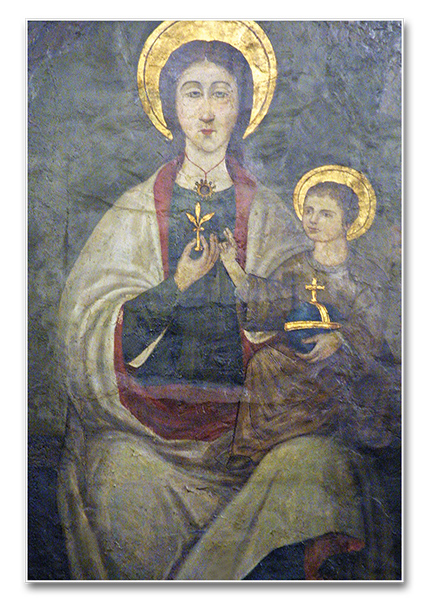
There is no beatitude without faith
45 “And blessed is she who believed that there would be a fulfilment of what was spoken to her from the Lord.”
It is interesting to note Elizabeth’s praise of Mary, her recognition of “She who believed.” Elizabeth was suffering the consequences of the incredulity of her husband who had been dumb for six months for having doubted the angelic announcement concerning the birth of St. John the Baptist. Elizabeth had plenty of time to meditate on the deep importance of the virtue of faith. This gave her increased admiration for the virginal and innocent faith of Mary Most Holy, who, for having fully believed the Angel, merited as a reward, the “fulfilment of what was spoken to her from the Lord.”
To believe is to follow Our Lady’s example. She neither demanded explanations nor placed conditions on the Angel’s message which might have suited her. Instead, she consented with docility to all that St. Gabriel foretold, showing that even more important than being Mother of the Redeemer—itself an incomparable grace—is conformity with God’s plans. 12 In the future years of His public life, when Jesus was told that His Mother was present, He would answer: “My mother and my brothers are those who hear the word of God and do it” (Lk 8: 21); and later, upon hearing Our Lady acclaimed for the gift of her divine motherhood, He would say (Lk 11: 28): “Blessed rather are those who hear the word of God and keep it!” With these assertions, Our Lord shows that He prizes Mary’s fidelity to His Word more than the incomparable privilege of her having given birth to Him in time.
III – The Lessons of the Visitation
The Visitation, outstanding for its mystical and symbolic meaning, is a milestone in the Christian Era, manifesting Our Lady’s mentality, made up of admiration, humility, unpretentiousness, affection, promptness, service, obedience, joy and interior life.
If we want our lives to be filled with this Marian light, let us implore her to grant us the grace of participating in her faith, so that we may discern the action of the Holy Spirit in our everyday existence. We do not need to neglect our family or professional obligations, or the duties of state inherent to our vocation, for it is precisely in the perfect exercise of these activities that we become holy. Like St. Elizabeth, let us be attentive to Mary’s presence.
One of the most beautiful lessons of the Liturgy of the Fourth Sunday of Advent is undoubtedly the importance of being loved by the Blessed Virgin. She loves us, not for any merit of our own, for what we have or do, but because we are children of God. Her love is unconditional. Let us ask, then, with fervour, during this week proceeding Christmas, for her to speak in the depths of our heart and transform us, in spite of everything, into enthusiastic heralds of Christ in the contemporary world. ◊
Notes
1 ST. AUGUSTINE. Confessionum, L.III, c.7, n.11. In: Obras, vol. II. (Ed.6). Madrid: BAC, 1974, p.142.
2 Cf. ST. THOMAS AQUINAS. Summa Theologiae, I, q.12, a.1; a.3.
3 Cf. GOMÁ Y TOMÁS, Isidro. El Evangelio explicado, Vol. I: Introducción, Infancia y Vida oculta de Jesús, Preparación de su Ministerio público. Barcelona: Rafael Casulleras, 1930, p.318; TUYA, OP, Manuel de. Biblia Comentada, vol. V: Evangelios. Madrid: BAC, 1964, p.759; FERNÁNDEZ TRUYOLS, SJ, Andrés. Vida de Nuestro Señor Jesucristo. (Ed.2). Madrid: BAC, 1954, p.22-24.
4 NICOLAS, Auguste. La Vierge Marie d’après l’Évangile, vol. II. Paris: Auguste Vaton, 1857, p.222.
5 Cf. ST. THOMAS AQUINAS, op. cit., q.5, a.4, ad 2.
6 WILLAM, Francisco Miguel. Vida de Maria, Mãe de Jesus. Petrópolis: Vozes, 1940, p.85.
7 ST. AMBROSE. Expositio Evangelii secundum Lucam, L.II, n.19. In: Obras, vol. I. Madrid: BAC, 1966, p.96.
8 MONSABRÉ, OP, Jacques-Marie-Louis. Petites Méditations pour la Récitation du Sainte Rosaire. (Ed.20). Paris: Lethielleux, 1924, p.90.
9 Cf. GARRIGOU-LAGRANGE, OP, Réginald. La Mère du Sauveur et notre Vie intérieure. Paris: Du Cerf, 1954, p.34-35.
10 CAMPANA, Émile. Marie dans le Dogme Catholique, vol. I. Montréjeau: J.-M. Soubiron, 1912, p.295-297.
11 Cf. ST. THOMAS AQUINAS,
op. cit., q.20, a.2.
12 Cf. NICOLAS, op. cit., p.414-419.



